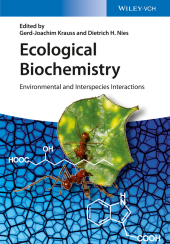 Neuerscheinungen 2014Stand: 2020-02-01 |
Schnellsuche
ISBN/Stichwort/Autor
|
Herderstraße 10
10625 Berlin
Tel.: 030 315 714 16
Fax 030 315 714 14
info@buchspektrum.de |

Gerd-Joachim Krauss, Dietrich H. Nies
(Beteiligte)
Ecological Biochemistry
Environmental and Interspecies Interactions
Herausgegeben von Krauss, Gerd-Joachim; Nies, Dietrich H.
1. Auflage. 2014. 440 S. 20 SW-Abb., 210 Farbabb. 276 mm
Verlag/Jahr: WILEY-VCH 2014
ISBN: 3-527-31650-7 (3527316507)
Neue ISBN: 978-3-527-31650-2 (9783527316502)
Preis und Lieferzeit: Bitte klicken
Zum ersten Mal seit zehn Jahren wieder behandelt ein Lehrbuch dieses immer wichtiger werdende Thema - gerade in Zeiten des globalen Klimawandels. Eine kurze Einführung zu Beginn von "Ecological Biochemistry" deckt die Grundlagen der Biochemie und Molekularbiologie in ausreichender Tiefe ab. Im Hauptteil konzentriert sich das Buch auf Pflanzen-Umwelt- und Bakterien-Umwelt-Interaktionen. Ergänzt wird dieser durch ein eigenes Kapitel über aquatische Systeme. Darüber hinaus ist ein ganzer Abschnitt den Methoden gewidmet, zu allen Themen sind Übungen und Zusatzmaterial online verfügbar.
The first stand-alone textbook for at least ten years on this increasingly hot topic in times of global climate change and sustainability in ecosystems.
Ecological biochemistry refers to the interaction of organisms with their abiotic environment and other organisms by chemical means. Biotic and abiotic factors determine the biochemical flexibility of organisms, which otherwise easily adapt to environmental changes by altering their metabolism. Sessile plants, in particular, have evolved intricate biochemical response mechanisms to fit into a changing environment. This book covers the chemistry behind these interactions, bottom up from the atomic to the system´s level.
An introductory part explains the physico-chemical basis and biochemical roots of living cells, leading to secondary metabolites as crucial bridges between organisms and the respective ecosystem. The focus then shifts to the biochemical interactions of plants, fungi and bacteria within terrestrial and aquatic ecosystems with the aim of linking biochemical insights to ecological research, also in human-influenced habitats.
A section is devoted to methodology, which allows network-based analyses of molecular processes underlying systems phenomena.
A companion website offering an extended version of the introductory chapter on Basic Biochemical Roots is available at
http://www.wiley.com/go/Krauss/Nies/EcologicalBiochemistry
PART I : BASICS OF LIFE
Basic biochemical roots (D.H. Nies)
Specialized plant metabolites: diversity and biosynthesis (A. Tissier, J. Ziegler, T. Vogt)
Evolution of secondary metabolism in plants (M. Wink)
PART II : ECOLOGICAL SIGNATURES OF LIFE
Systematics of life, its early evolution, and diversity of its ecological function (D.H. Nies)
Communities and ecosystem functioning (H. Rennenberg)
Food chains and nutrient cycles (F. Bärlocher, H. Rennenberg)
PART III : BIOCHEMICAL RESPONSE TO PHYSICOCHEMICAL STRESS (ABIOTIC STRESS)
Information processing and survival strategies (I. Heilmann)
Oxygen (K.-J. Dietz)
Light (T. Kretsch)
Water (W. Zschiesche, K. Humbeck)
Mineral requirement and insufficiencies (E. Peiter)
Mineral deficiencies: Carnivorous plants and fungi (G.-J. Krauss, G. Krauss)
Excess of metals (D.H. Nies, E. Freisinger, G.-J. Krauss)
Xenobiotics from human impacts (M. Solé, D. Schlosser)
PART IV: ORGANISMAL INTERACTIONS (BIOTIC STRESS)
The biofilm mode of life (H.-C. Flemming)
Rhizosphere interactions (S. Schrey, A. Hartmann, R. Hampp)
Plant animal dialogues ( S. Preiß, J. Degenhardt, J. Gershenzon )
PART V: THE METHODOLOGICAL PLATFORM
Sensing of pollutant effects and bioremediation (G.-J. Krauss, D. Schlosser)
The -omics tool box (D. Schaumlöffel)
Microscope techniques and single cell analysis (B. Hause, G. Hause)


